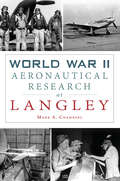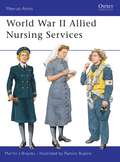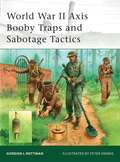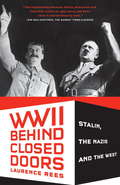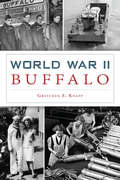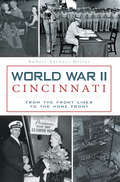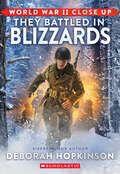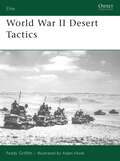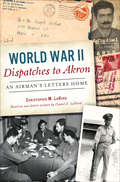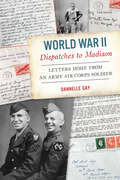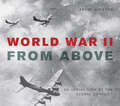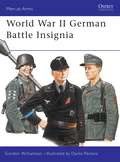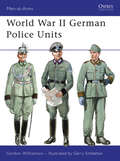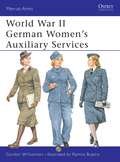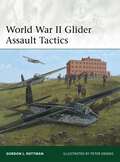- Table View
- List View
World War II (SparkNotes History Notes)
by SparkNotesWorld War II (SparkNotes History Note) Making the reading experience fun! SparkNotes History Guides help students strengthen their grasp of history by focusing on individual eras or episodes in U.S. or world history. Breaking history up into digestible lessons, the History Guides make it easier for students to see how events, figures, movements, and trends interrelate. SparkNotes History Guides are perfect for high school and college history classes, for students studying for History AP Test or SAT Subject Tests, and simply as general reference tools.Each note contains a general overview of historical context, a concise summary of events, lists of key people and terms, in-depth summary and analysis with timelines, study questions and suggested essay topics, and a 50-question review quiz.
World War II (What They Don't Tell You About #31)
by Robert FowkeDid you know that Adolf Hilter wasn't, in fact, German?The Second World War brought horror and heartache to millions of people all over the globe, and it turned everyday living upside down too. Any history book will give you the boring facts THEY think you should know, but only this one will tell you what life during World War II was REALLY like ...
World War II Aeronautical Research at Langley (Military)
by Mark A. ChambersThe effort to win the war began at home--and for the researchers at Langley Memorial Aeronautical Laboratory, enhancing America's military aviation arsenal was the key to victory.Formed in 1915, the National Advisory Committee for Aeronautics established itself over the next 25 years as one of the world's finest research organizations. When World War II began in 1939, the NACA employed a mere 500 workers and maintained a budget slightly in excess of $4 million. To meet the demands of the war, a special partnership was quickly forged between NACA researchers, industry designers, and military planners. The Langley laboratory possessed world class aeronautical research facilities and flight research operations, making it ideally suited to help America win the war.Military historian Mark Chambers tells the story of the monumental task of developing the planes that spurred Allied victory in World War II.
World War II Akron (Military)
by Tim CarrollWhen World War II engulfed the nation, the men and women of Akron dutifully played their part in the epic struggle. Keyes Beech ducked grenades as marines raised the American flag at on Iwo Jima. Newspaper magnate John S. Knight watched the Japanese surrender on the USS Missouri just five months after his son was killed in Germany. On the homefront, Goodyear manufactured blimps used to hunt down Nazi submarines, and noted Beacon Journal cartoonist Web Brown pledged his talent and his pen to boosting morale at home and abroad. Replete with more than one hundred images, including many of Brown's wartime drawings, this thrilling account by local author Tim Carroll recalls all that Akron gave for freedom.
World War II Allied Nursing Services
by Ramiro Bujeiro Martin BrayleyThe skill and care of the women of the Allied military nursing services was remembered gratefully by hundreds of thousands of wounded servicemen of World War II (1939-1945). The small peacetime services increased rapidly by enrolling reservists and volunteers; the great majority of the nurses who cared for Allied casualties were 'civilians in uniform', who worked tirelessly under difficult conditions and - in tented hospitals close to the front lines - in real danger; many nurses paid for their devotion with their lives. This first-ever fully illustrated study of the US, British, Commonwealth, and other nursing organisations includes many unpublished photographs and 24 meticulously illustrated colour figures.
World War II Allied Sabotage Devices and Booby Traps
by Peter Dennis Gordon RottmanOsprey's elite title dealing with various sabotage devices and booby traps that were used by the British and the Americans during World War II (1939-1945). Following Churchill's directive to set occupied Europe ablaze, the SOE and later its American sister organization, the OSS, were deployed across the continent. Outnumbered, surrounded and in great peril, these brave agents were armed with a wide variety of devices to help them achieve their objectives, including numerous pieces of sabotage equipment and cunning booby traps. This book examines these different pieces of equipment and the technicalities involved in deploying them effectively. It also discusses the specialist equipment developed by Special Forces units, including the SAS Lewes Bomb. Touching on some of the stranger developments, such as explosives disguised as lumps of coal, the author goes on to describe the German clearance techniques that were developed to avoid these dangers.Complete with specially commissioned artwork and period diagrams, together with detailed descriptions of the dangerous missions of Allied agents, this book is a fascinating insight into the secret war behind enemy lines.
World War II Arroyo Grande (Military)
by Jim GregoryOn December 7, 1941, war came to Arroyo Grande when two local sailors were killed on the USS Arizona at Pearl Harbor. People from the small town were thrust into great circumstances and quickly answered the call for action. A local storekeeper's son won the Silver Star after he brought his flaming B-17 safely back to base. A valley farmworker served with the famed 442nd Regimental Combat Team, largely composed of soldiers of Japanese descent. Chinese guerrillas commanded by Mao Zedong--the future Chairman Mao--threw a birthday party for an Arroyo Grande soldier. At home, community groups like the Arroyo Grande Women's Club brought packed lunches for their Japanese American neighbors on the morning they were forced to leave for the internment camps. Local author Jim Gregory brings to life the sorrows and triumphs of a dramatic period in local history.
World War II Axis Booby Traps and Sabotage Tactics
by Peter Dennis Gordon RottmanBooby traps laid by troops in war zones in World War II (1939-1945) are largely neglected in histories and memoirs, and rarely examined in detail. Yet for a soldier, the threat of booby traps was hugely significant and the ability to find and disarm them was essential. This is the first comprehensive study of World War II Axis battlefield sabotage equipment, using information from rare wartime intelligence publications covering both Allied and Axis practice to identify, illustrate and describe the vintage munitions used in World War II. Examining all aspects of this secretive subject, from the equipment used to the techniques of placing and uncovering them, this book is an invaluable resource, revealing the daily risks faced by soldiers on the ground through the course of the war.From the Trade Paperback edition.
World War II Behind Closed Doors: Stalin, the Nazis and the West
by Laurence ReesIn this revelatory chronicle of World War II, Laurence Rees, winner of the 2006 British Book Award for History, documents the dramatic and secret deals that helped make the war possible and prompted some of the most crucial decisions made during the conflict. Drawing on material available only since opening of archives in Eastern Europe and Russia, Rees re-examines the key choices made by Stalin, Churchill and Roosevelt during the war. And as the truth about Stalin's earlier friendly relationship with the Nazis is laid bare, a devastating and surprising picture of the Soviet leader emerges. The emotional core of the book is the amazing new testimony obtained from nearly a hundred separate witnesses from the period--former Soviet secret policemen, Allied seamen who braved Arctic convoys and Red Army veterans who engaged Germans in hand-to-hand fighting on the Eastern Front. Their dramatic personal experiences make clear in a compelling and fresh way the reasons why the people of Poland, the Baltic states and other European countries simply swapped the rule of one tyrant for another. Rees' ability to weave high politics--the meeting of the Allied leaders at Tehran, Yalta and Potsdam--with the dramatic personal experiences of those on the ground who bore the consequences of their decisions is eye opening. World War II Behind Closed Doors will change the way we think about the Second World War.
World War II Buffalo (Military)
by Gretchen E. KnappWhen President Roosevelt visited Buffalo in November 1940, he found a hardworking city with a large immigrant population manufacturing aircraft for the Allies. Nearby Fort Niagara inducted over 100,000 young men, resulting in an acute labor shortage. American Brass, Bell Aircraft, Chevrolet, Curtiss-Wright, Houde Engineering and Republic Steel reluctantly, then gladly, hired women. More than 300,000 defense workers toiled in hot factories for high wages despite transportation, housing and food shortages. The aircraft plants alone employed 85,000 on forty-eight-hour workweeks. Buffalonians watched the flag raising at Iwo Jima, participated in the Manhattan Project and observed the formal surrender of Japan in Tokyo Bay. Author Gretchen Knapp brings to life the challenges and contributions of daily life during wartime.
World War II Cincinnati: From the Front Lines to the Home Front (Military)
by Robert Earnest MillerWorld War II transformed Cincinnati from a relatively important but parochial midwestern city into a teeming bastion of military might. While thousands served in the nation's armed forces, others contributed to rationing programs, salvage drives, blackouts and war bond rallies. Scores of community-based programs blossomed as Cincinnatians on the home front threw themselves wholeheartedly into the "total war" that Washington believed necessary for victory. After answering the call to treat domestic duty as seriously as any battleground assignment, the Queen City emerged from the war as utterly changed as the nation itself. Author Robert Miller brings to life this dramatic, patriotic period in Cincinnati's history.
World War II Close Up: They Battled in Blizzards
by Deborah HopkinsonAward-winning author Deborah Hopkinson brings to life the stories of the men who fought in World War II's Battle of the Bulge, attacked without warning, weathering deadly blizzards, and facing an enemy who had nothing to lose. Perfect for fans of the I Survived series!In the dead of winter, deep in the Forest of Ardennes, as the devastation of World War II drew to a close, a desperate Nazi army launches a surprise attack on Allied forces in the early morning hours of December 16th.As the ground is blown apart by mortar shells and an endless curtain of bullets rains down upon them, the mostly young, inexperienced, and exhausted Allied soldiers must take up arms against the Nazis. Blinded by dangerous blizzards and hampered by the rough terrain, they fight to hold their positions until reinforcements arrive.But deadly weather conditions and the suprise attack make matters difficult, and soon, the Allied forces are overwhelmed -- outmanned, outgunned, and underprepared.As winter continues and the Battle of the Bulge rages on, it will take an unprecedented combination of determination, grit, and unimaginable courage to thwart the Nazis's plans and defeat them, once and for all.Sibert Honor author Deborah Hopkinson transports readers to the blistering cold of Belgium's Ardennes Forest with this daring examination of one of the most infamous battles in history. Drawing on the true accounts of soldiers and nurses and others who lived to tell the tale, and featuring rare photographs, Deborah Hopkinson seamlessly weaves together the stories of the men and women who risked everything. They Battled in Blizzards is sure to thrill every history fan!Scholastic Focus is the premier home of thoroughly researched, beautifully written, and thoughtfully designed works of narrative nonfiction aimed at middle grade and young adult readers. These books help readers learn about the world in which they live and develop their critical thinking skills so that they may become dynamic citizens who are able to analyze and understand our past, participate in essential discussions about our present, and work to grow and build our future.
World War II Close Up: They Saved the Stallions
by Deborah HopkinsonAward-winning author Deborah Hopkinson deftly brings to life the thrilling true story of the desperate fight to save the world-famous Spanish Riding School in Vienna and its beloved Lipizzaner horses during World War II, perfect for fans of I Survived!Scholastic Focus is the premier home of thoroughly researched, beautifully written, and thoughtfully designed works of narrative nonfiction aimed at middle grade and young adult readers. These books help readers learn about the world in which they live and develop their critical thinking skills so that they may become dynamic citizens who are able to analyze and understand our past, participate in essential discussions about our present, and work to grow and build our future.In the closing months of World War II, American bombs rained down on Nazi Germany and its territories, including Austria.As glass shattered around them in Vienna, an ordinary-looking horse named Nero and his stable mates, the dancing white Lipizzaner stallions of the famed Spanish Riding School, quiver and shake in fear. But they do not panic. Somehow, they sense the school's director, dedicated horseman Alois Podhajsky, will do everything he can to keep them safe.Yet Alois can't do it alone. And in the chaotic last days of the war, as their fate becomes more uncertain than ever, Nero will play a key role in helping Alois appeal for aid from an unlikely ally -- America.But time is running out. It will take a daring band of American soldiers -- along with horse lovers from opposing sides -- to pull off a secret mission to save the Lipizzaners from certain destruction. United by their love of horses, these unsung heroes risked their lives to preserve the majesty of this rare breed for generations to come.Join the ride as critically acclaimed author Deborah Hopkinson brings to life the exhilarating true story of Operation Cowboy and the miraculous survival of the Spanish Riding School. Featuring rare family photos and told for the first time for young readers, They Saved the Stallions is bound to please every history fan and horse lover.
World War II Desert Tactics
by Adam Hook Paddy GriffithOsprey's study of desert tactics employed in North Africa during World War II (1939-1945). In 1940-43 North Africa saw the first major desert campaign by modern mechanized armies. The British, Italians, German Afrika Korps and US Army all addressed and learned from the special problems - human, logistical, mechanical and tactical - of the desert environment, most significantly a terrain empty of resources and offering little chance of concealment. Paddy Griffith traces the fast-learning development of armor, artillery and infantry tactics in this exceptional situation and illustrates it using references to the major engagements in the North African theater, which involved some of the greatest tacticians of World War II in one of the pivotal arenas.
World War II Dispatches to Akron: An Airman's Letters Home
by Christopher LaHurdA bombardier’s story of serving in the skies over Europe—and surviving in a POW camp—as told through his correspondence with his Ohio family.On his twenty-sixth horrifying mission over the hostile skies of Nazi Europe, a charismatic bombardier, seated at the nose of a B-17, strapped on his parachute as his disintegrating bomber dropped uncontrollably to the ground. What got him to this point, the ensuing months behind barbed wire, and his daily letters written to his family in Akron, Ohio, makes for an emotionally intense memoir. This is the true account of a single individual who represents the countless unsung warriors of the greatest generation during World War II.Previously published as A Story of One
World War II Dispatches to Madison: Letters Home from an Army Air Corps Soldier (Military)
by Dannelle GayAmidst the chaos and uncertainty of World War II, one soldier found solace and strength in letters from home. An Army Air Corps serviceman from a prominent Madison family, Bob Gay paints a vivid picture of a young man's journey through a tumultuous era, revealing the profound love he held for his family. As Gay fulfills his duty on the frontlines, his mother's unwavering support shines through her involvement with the Red Cross, while his father's dedication as a ration board member and air raid warden mirrors a nation's collective sacrifice. World War II Dispatches to Madison is a tribute to a humble and kind soul who never sought the spotlight. In honor of her ancestor Robert Gay, Dannelle's book will benefit the Wounded Warrior Project.
World War II For Dummies (For Dummies Ser.)
by Keith D. DicksonInvestigate the factors that led to war Examine key turning points, including D-Day and Hiroshima Get to know the opposing forces — the Allies and the Axis Explore the greatest war in history World War II was the most destructive conflict of the 20th century. How did it happen — and why? Packed with fascinating anecdotes, interesting sidebars, and top ten lists, this friendly reference contains everything you need to know about World War II, from the issues that caused the war to its most crucial confrontations and what happened in the aftermath. Read about important figures on both sides, study Hitler's war against the Jews, and find out how the Allies finally achieved victory. Whatever your interest, World War II For Dummies is your go-to guide. Inside … The significance of World War II Hitler's rise to power The invasion of Eastern Europe Pearl Harbor and U.S. neutrality Life and labor on the home front The Holocaust Liberation and what came next
World War II From Above: An Aerial View of the Global Conflict
by Jeremy HarwoodThis pictorial military history examines the use of spy planes by both sides of WWII as they battled to gain advantage through aerial intelligence.In World War II From Above, Jeremy Harwood examines a little-known aspect of intelligence gathering operations as they evolved throughout the conflict. The volume features dozens of eye-catching aerial reconnaissance photographs drawn from the archives compiled by all the major fighting powers. His accompanying text profiles the daring pilots who took these photographs and the photographic interpreters who pioneered a new science to reveal the secrets they contained.This inspiring and informative history focuses on crucial operations from both the Allied and Axis perspectives—from the American Doolittle Raid against Japan to the numerous Allied battles against Germany’s cutting-edge U-boats to the Battle of Monte Cassino and a score of other epic campaigns.Told through photographs that have largely never before appeared in print outside of their reconnaissance origins, World War II From Above combines history with photography, placing the reader in the midst of the action.
World War II German Battle Insignia
by Darko Pavlovic Gordon WilliamsonThe remarkable war effort of the German armed forces on three fronts between 1939 and 1945 was recognised by a wider range of insignia than seen in the Allied armies. While the Wehrmacht displayed fewer unit insignia than the Allies, a glance at a German soldier's tunic could reveal much more about his actual combat experience. In this book an experienced researcher explains and illustrates the Battle and Assault Badges of the Army, Waffen-SS and Luftwaffe ground troops of World War II; the sleeve shields and cuffbands issued to mark service in particular campaigns; wound badges, commemorative medals, and other types of insignia.
World War II German Police Units
by Gerry Embleton Gordon WilliamsonThe wartime Police were headed by Himmler as chief of the SS; and throughout the occupied nations the regional SS commanders were specifically termed 'Higher SS and Police Leaders'. Hitler's police was not a single service, but a vast machinery which included many special categories ranging from conventional criminal detectives, and municipal and rural police to combat battalions sent to Russia, and from border and customs police to special railway and waterway departments, fire brigades and emergency engineer squads, and even a colonial service for North Africa. The author explains the origins, the complex organization and the particular duties of the many different police branches that formed such a critical part of the Nazi apparatus and ensured that control was maintained inside Hitler's Fortress Europe. His painstaking research has unearthed fascinating new information about the German police services and their many different uniforms and insignia, which are recreated in the meticulously detailed color artwork.From the Trade Paperback edition.
World War II German Womens Auxiliary Services
by Ramiro Bujeiro Gordon WilliamsonUnder the Nazi regime, Hitler's conservative views on the place of housewives and mothers in society limited German women to a much less active role in World War II (1939-1945) than their British and Allied counterparts. Nevertheless, the demands of a prolonged war did see German women in a range of uniforms as auxiliaries with the Army, Navy, Air Force and SS, particularly in the signals and air defence services. This unique book explains and illustrates these organisations and their uniforms and insignia, as well as Red Cross nurses, and auxiliaries of the Labour Corps, Customs Service, National Socialist Women's Organisation, and League of German Maidens (Hitler Youth).
World War II Glider Assault Tactics
by Peter Dennis Gordon RottmanFrom Eben Emael to Crete, Sicily, Market Garden, the Rhine, and Burma, glider-borne paratroopers brought extra firepower to bear using techniques that helicopter troops adapted for modern air cavalry techniques.This book explains the development and organization of World War II glider troops, their mounts, and the air squadrons formed to tow them; the steep and costly learning-curve, as armies and air forces worked out the techniques needed to carry and deliver men and equipment safely to the chosen landing zones; and the tactics that such troops learned to employ once they arrived on the battlefield. All these aspects are illustrated by reference to famous operations, including the German assault on Crete (1941), the Allied assault on Sicily (1943), the Allied Normandy landings and Operation Market Garden (1944), the Rhine crossings (1945), and also the Allied operations in Burma to insert and resupply the "Chindits" behind Japanese lines (1944).The major weakness of the military paratrooper is the limited load of kit that he can carry during the jump, making his combat endurance short unless he is quickly re-supplied. Military gliders came of age in World War II, when glider-assault infantry were the forerunners of today's helicopter-delivered airmobile troops. From the light pre-war sports and training machines, several nations developed troop-carrying gliders capable of getting a whole squad or more of infantry, with heavy weapons, onto the ground quickly, with the equipment that paratroopers simply could not carry. Gliders were also developed to carry light artillery, antitank guns, jeeps, and even special lightweight tanks. They made up at least one-third of the strength of US, British, and German airborne divisions in major battles, and they also carried out several daring coup de main raids and spearhead operations. However, the dangers were extreme, the techniques were difficult, the losses were heavy (particularly during night operations), and the day of the glider assault was relatively brief.
World War II Heroes: Ten True Tales
by Allan ZulloThis is a good book about 10 different men who fought in the War. Each man earned the Congressional Medal of Honor.
World War II Historical Reenactment in Poland: The Practice of Authenticity (Routledge Studies in Second World War History)
by Kamila Baraniecka-OlszewskaThis book explores the consequences of the latest political shifts in Central Eastern Europe: the rise of right-wing parties and, among other things, politics becoming more invested in history. These phenomena coincide and overlap with the democratisation of history by turning the past into a hot topic, persistently present in the public sphere and often evoking strong emotions. Ethnographic research (conducted in 2012-2016) focusing on how World War II reenactors experience the past serves as the basis to analyse the ways in which the group uses the widespread, often institutionalised interest in history to – on the one hand – become involved in debates on World War II and the remembrance thereof, and – on the other – to authentically experience this past. The volume therefore analyses how physical the process of creating and experiencing grassroots visions of the past is, and how these visions interact with the public discourse about the past. Reenactors’ ability to marry the often-contradictory orders of historical truth, authenticity, and representation is explored. Moreover, Baraniecka-Olszewska analyses how the reenactors overcome various obstacles on their way towards authentic experiences, performing history through their bodies.
World War II History for Kids: 500 Facts (History Facts for Kids)
by Kelly Milner HallsIncredible World War II facts for curious kids ages 8 to 12Kids don't need long, boring textbooks to learn about history! Starting with the events that set the stage for war and finishing with its aftermath, World War II History for Kids helps them explore the past through interesting and memorable facts they can share with their friends and family.Go beyond other World War 2 books for kids with:500 facts—This book teaches kids all about the heroism and horrors of World War II, one informative tidbit at a time.The complete timeline—Kids will learn all about important people, places, and events from before, during, and after the war.A leg-up on learning—These facts provide kids with a head start on the topics they'll be covering in class, plus things they might not learn in school.Help young learners better understand what happened during WWII with this engaging, fact-driven history book.


